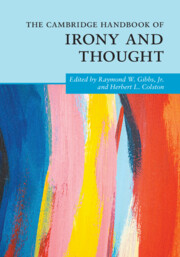Book contents
- The Cambridge Handbook of Irony and Thought
- Cambridge Handbooks in Psychology
- The Cambridge Handbook of Irony and Thought
- Copyright page
- Contents
- Contributors
- Part I Introduction
- Part II The Scope of Irony
- Part III Irony’s Impact
- Part IV Irony in Linguistic Communication
- Part V Irony, Affect, and Related Figures
- 14 Irony and Humor
- 15 Emotional Responses to Sarcasm
- 16 Irony, Exaggeration, and Hyperbole: No Embargo on the Cargo!
- 17 Irony and Its Overlap with Hyperbole and Understatement
- 18 Irony and Satire
- 19 Hypocrisy and Situational Irony
- Part VI Irony in Expressive, Nonlinguistic Media
- Index
- References
17 - Irony and Its Overlap with Hyperbole and Understatement
from Part V - Irony, Affect, and Related Figures
Published online by Cambridge University Press: 20 December 2023
- The Cambridge Handbook of Irony and Thought
- Cambridge Handbooks in Psychology
- The Cambridge Handbook of Irony and Thought
- Copyright page
- Contents
- Contributors
- Part I Introduction
- Part II The Scope of Irony
- Part III Irony’s Impact
- Part IV Irony in Linguistic Communication
- Part V Irony, Affect, and Related Figures
- 14 Irony and Humor
- 15 Emotional Responses to Sarcasm
- 16 Irony, Exaggeration, and Hyperbole: No Embargo on the Cargo!
- 17 Irony and Its Overlap with Hyperbole and Understatement
- 18 Irony and Satire
- 19 Hypocrisy and Situational Irony
- Part VI Irony in Expressive, Nonlinguistic Media
- Index
- References
Summary
This chapter examines the possibility that hyperbole and understatement are distinct notions and not necessarily under the superordinate concept of irony. Hyperbole relates to exaggeration or overstatement, while understatements are viewed as scalar shifts that are quite the opposite of hyperbole (i.e., presenting something as less significant than it is). She examines empirical evidence on the discourse goals associated with irony, hyperbole, and understatement to suggest that irony is frequently a part of hyperbole and understatement (e.g., to achieve the goals of contrast, expectations, and indeterminacy), but can exist on its own (e.g., to achieve the goal of an ironic attitude through evaluation accounts, negative-attitude accounts, and dissociative-attitude accounts). Both hyperbole and understatement are also evaluative, but not necessarily in an ironic way. Most generally, understatement and hyperbole may share common mechanisms with irony, yet are still important rhetorical figures in their own right.
- Type
- Chapter
- Information
- The Cambridge Handbook of Irony and Thought , pp. 310 - 324Publisher: Cambridge University PressPrint publication year: 2023



